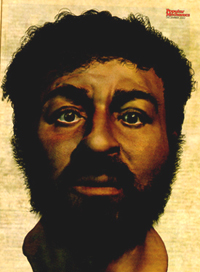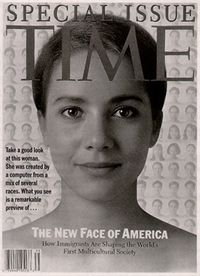|
D/Riftin' To:: Deleuze and Guattari's talkin' to us about faciality and how we must lose it. We must lose our faces! D&G write of "a face: the white wall/black hole system" (TP 167). It's
A broad face with white cheeks, a chalk face with eyes cut in for a black hole. Clown head, white clown ... Holy Shroud [Think of the one at Turin] (167). "The face" is not a cause, nor an effect, but the face, D&G write,
constructs the wall that the signifier needs in order to bounce off of; it constitutes the wall of the signifier, the frame or screen. The face digs the hole that subjectification needs in order to break through; it constitutes the black hole of subjectivity as consciousness or passion, the camera, the third eye (168), which as Barthes tells us, reflecting on the lens opening, is another hole that is used to create a hole on the white wall (Camera Lucida 78). |
|
Continuing:: But then, D&G say:
It is not exactly the face that constitutes the wall of the signifier or the hole of subjectivity. The face, at least the concrete face, vaguely begins to take shape on the white wall. Do you get the impression that D&G are talkin' about a film being projected on a screen? Life as it is on the screen. Freud's screen memories, perhaps. Or Eisenstein's screen memories? They continue: "The face vaguely begins to appear in the black hole. In film, the close-up of the face can be said to have two poles": light and shadows. Simply and nothing but light (luminosity) and shadows (darkness). (Much of this is discussed at length in Deleuze's Cinema 1 and 2.) I will give you some examples, but first, D&G go on to say that the face does not, contrary to what they previously said, construct itself, but the face, with its light and shadows, is "engendered by an abstract machine of faciality" (ATP 168). Here are three examples from The Battleship Potemkin, rather famous closeups of faces framed in the tiny black hole of the camera:
So it is the abstract machine (machinics), then the camera--But is the camera also the abstract machine?!--and finally the tiny black hole of the lens opening that makes for faciality. Let us not forget that the camera is based on our eyes-lenses, and in an obscurancy perhaps it is the eyes that are based on the camera. Camera obscura, Lucida. (Sarah Kofman has rather brilliantly written about all this in Camera Obscura of Ideology.) I have added this fourth, color clip for contrast. W/B compared to color (bright reds and oranges) point to, or remind me of, Deleuze's discussion in Cinema 1 of how light, darkness (shadow), and color make for three very different subjectivities. |
|
D/Riftin' To:: We have had no shortage of cameras on us. I remember the good nuns and priests saying to us in the third grade that God was always watching us. As D&G say: "Christian education exerts spiritual control over both faciality and landscapity" (172) D&G go on to talk about the pedagogy, "a strict discipline," that taught faciality by way of architecture, painting, and film: "The closeup in film treats the face primarily as a landscape; that is the definition of film, black hole and white wall, screen and camera" (172). |
|
. . . Do I need to recall that we are under constant surveillance today. If God does not, the god-cameras do live! . . . |
|
Speaking of the death of God, D&G go on to tell us in ATP that in terms of faciality, the white face is that of Christ (176-78). HIS is the FACE, the white, chalky face. At this point, D&G get into a discussion of racism predicated on this white face, which I will not go into here. But what might appear to be rather curious is that D&G say that what should go for faciality is basically "inhuman" ... Yes, the face is a mask covering the inhuman ... and that, for all concerned, we must lose this face, not simply because it is racist, but because it under-determines our being, keeping us from becoming whatever. The face, faciality, puts us under constant subjectivication. By now, it is understood--whether any of us can accept it or not--that subjectivity is not the sign of agency and the conditions for the possibility of changing the world for the better; sub-jectivity is the sign of repression, suppression, and political oppression. There is nothing universal about faciality, D&G tell us (176). Numerous so-called "primitive societies" do not invest, as we do, in individual-that-is-not-individual-faciality. Have you looked at or read Allure magazine? Have you been reading the articles in the NYTimes Sunday magazine on facial studies? Reading and scanning faces? Transplanting faces? Examples are everywhere; faciality, after all, is what constitutes "everywhere" for us! (But Andre Leroi-Gourhan has written about all this, in terms of hands-gestures, face-faciality, in Gesture and Speech.)... My son David, BTW, works for a company that develops, sells, and installs scanning programs and hardware. E.g., to grocery stores. Soon you will have your thumb prints scanned and then, when you are used to giving your thumb and all-other-finger prints, you will give your face print. In a sense your identity will have been stolen. But listen to me--Are you listening to me!?--this is not at all what I mean when I talk about losing face, faciality!!! It is not just, but it's near enough, that what goes for faciality is racist and sexist (cf. Wendy Steiner, Venus in Exile); it's that it is, in the meantime, the most insidious and invidious of problems. So let's continue.... We come closer to seeing a possible, other transition into losing face, There is so much more to say about this film.... But the question.less is What is at issue here? Really, it is not just the case of our reclaiming other sorts of faces, nor of stealing the identity of anOther's face such as God or Christ, or unjust a humble, though eccentric human being such as a movie star, with his film credit history. Just take the face of Christ! How many movies has tHis face been in! How many times--countless times--has Christ had His face taken and redone. D&G tell us that there were other, though suppressed faces: "On the brighter side, painting has exploited all the resources of the Christ-face. [There are] Christ-athlete at the fair, Christ-Mannerist queer, Christ-Negro, or at least a Black Virgin at the edge of the wall" (178). There is also Andres Serrano's "Piss Christ." Here is yet another face, this one appeared in Popular Mechanics and is supposed to be the REAL Christ, according to forensic scientists:
But as I keep saying, the issue is the loss of Christ's face, all the possible faces, from pure white to pure black, and also the loss of the multi-colored Rose window at the back of cathedrals, seen only as we depart--looking up--from the church to the outside world, the multifoliate and multicolored Rose window that is to be a depiction of Dante's representation of G-d, in all His beatific splendor. Although I admire the
|
|
Continuing:: So the issue is not the many faces of Christ. Rather, the issue is, as Deleuze says in Dialogues, "Christ invented the face." (But how[l] did He do that! By leaving a photo, I would presume, of His face on Veronica's scarf. Remember Christ is carrying His cross, bleeding and sweating from His face, and Veronica offers to wipe His face.) For Deleuze, the problem is "how to unmake the face by liberating in ourselves the questing heads [what D&G go on to call "probe heads"] which trace the lines of becoming? How to get past the wall while avoiding bouncing back on it, behind, or being crushed? How to get out of the black hole [determinative negativity] instead of whirling round in its depths...?" (46). The question is How to lose face? Yes, even in the sense of credibility, ethos! In the sense of losing one's subjectivity to move toward the conditions for the compossibilty of becoming. Flux. What is seen in the face, what is exposed by way of the face, is "the dirty little secret ... on which the craze for interpretation feeds" (46). Deleuze is not interested in perpetual interpretations (48-49), but in inventing. Becoming. Not by way of interpreting faces with their secrets, but by wayves of inventing through conceptual personae (see What is Philosophy? 61-83) and then losing face altogether.
A Sidebar::I read a statement about 6 months ago--we discussed it on Greg Ulmer's INVENT-L--about the frontier of Web design being closed. Basically, what was stated is that correct design for the Web, for Web pages, has been finally determined! Interface has been realized. Christ is at last painted as He should be painted. It was that olde time Christianity again and the supposed new time forensic scientists, telling us What Christ was to officially look like. (But it is not that he is white, but also black, brown, red, yellow. None of this rainbow is the point. It is--so to speak--that Christ's work has been completed in terms of the faciality of the Web.) Well, down with HTML editors. Down with Gurus and Wonks of the Web who tell us What is what and When it is all completed. We have yet to begin. What we will do is to create an eighth day, one without the pedagogy of negativity. Wait until we lose our faces, faciality, on the Web. Wait until we wipe clean the face, and expose the inhuman, or the stranger that lurks there. The becoming. Yes, the dirty little secret was the suppression of, the oppression of, the inhuman. Perhaps a third figure (is) coming. Slouching. Toward Purdue. Here @ C&W. To be Reborn again. |
| Photo in background: from Robert Poole's Toward a Theory of Deep Subjectivity. It is a photo of Russians meeting Chinese, East meeting East, on a frozen lake, yet across a binding of a shadow (which presented itself when I photocopied the double-page spread of the photo.) But then, it's erased here! |

